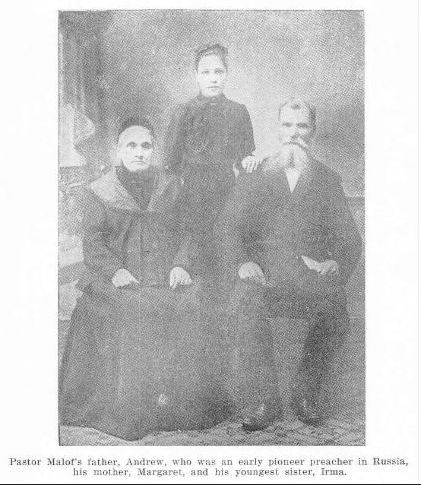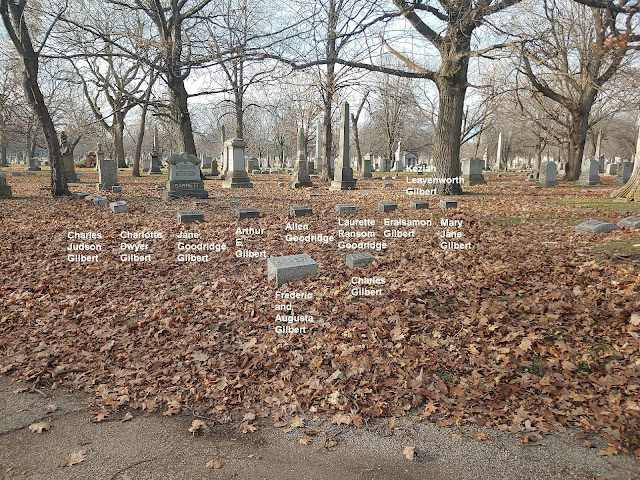I said in one of my recent articles for this blog "Evanston has ALOT of history." This morning I was checking ebay for interesting items from Evanston and I ran across this postcard:
It's a little hard to read, but at the bottom it says "The Rainbow Family Orchestra of Riga - Pastor and Mrs. Fetlers' Children." Here's the back of the card:
On the left side above is this:
I decided this would be another piece of Evanston history that would fit well into this blog so I am going to tell you the story of Pastor and Mrs. Fetler and their thirteen children.
William Andreyevitch Fetler was born July 28, 1883 in Talsi, Kurland, Latvia. His parents were Andreis R. Fetler and Margarethe Bahtze (sometimes written as "Bace") In addition to William they had five other children: Melanie Nelly (1890-1977), Robert (1892-1941), Irma Margaret (1899-1993), Antonia (????-????), and Leonard (????-????). Here is a photo of William's parents with his sister Irma:
The family name was originally Fetler, but at some point William had his name legally changed to Basil Andrew Malof. He explained that "Malof" was derived from a Russian adjective meaning "little," and this better described someone who realized the greatness and majesty of Almighty God.
He graduated from high school in the Village of Tuckums, Latvia in June of 1898. His first job was as interpreter in the Court of the Justice of the Peace in Riga, Latvia.
Malof had felt the call to preach since he was a young boy. He preached his first sermon at the age of 16 in Dinaminde, near Riga. In 1903 he enrolled at Spurgeon's Pastors College in London, England, run by the Rev. Thomas Spurgeon, the British reformed Baptist minister. In 1907, after completing his course of studies, he was ordained to the ministry by Spurgeon.
As Malof's popularity grew, he was approached by Orthodox Church officials who urged him to join the State Church, offering at first to make him a bishop, and then an archbishop. Malof's response: "If you would make me the Pope, perhaps I might consider." As you can imagine, his outspoken ways caused him to amass many enemies that would come after Malof when they considered it expedient.
Malof made his first trip to the United States in 1911 in response to an invitation from the Grace Temple in Philadelphia, Pennsylvania.
On July 13, 1913 he married Barbara Ivanovna Kovalevsky (1890-1969) in St. Petersburg. The groom was twenty-nine; the bride was twenty-two.
Barbara Ivanovna Kovalevsky was born September 20, 1890 in Grodno, Poland. Unfortunately nothing is known of her parents or if she had any siblings. Here is a photo of her from about the time she married William/Basil:
 |
| Barbara Ivanovna Kovalevsky |
Here is a photo from their wedding:
In 1914 Malof's outspoken ways caught up with him when he was arrested during a church service and given ten minutes to gather up his wife and three month old son Daniel to prepare for the long, cold journey for his permanent banishment to Siberia. After some negotiations, in December of 1914 the offer was made to Malof that if he signed a confession, his mandatory prison sentence would be changed to banishment abroad. Malof gladly signed. After he left Russia, he traveled first to Sweden and ultimately to his final destination: the United States.
 |
| Basil A. Malof |
In November of 1920 Malof presented 23 Russian missionaries for ordination at the Grace Temple, Philadelphia. On November 30, 1920 Basil Malof sailed from New York to Europe with his newly-minted missionaries.
From 1920 to 1939 Malof traveled throughout Europe organizing Russian missionary work in Poland, Romania, Bulgaria, Soviet Russia, Latvia, Estonia, Germany, France and Switzerland.
One way to keep track of Malof's travels is by looking at where his children were born. Here are his thirteen children along with their places of birth:
Daniel William Fetlers (1914-1995) Born St. Petersburg, Russia
Timothy Fetler (1915-1981) Born New York
Lydia Fetler/Mrs. John K. Hartsock (1917-2008) Born New York
Mary Fetler/Mrs. Kellogg Blair Miller (1918-2013) Born Philadelphia
Paul Enoch Fetler (1920-2018) Born Philadelphia
John Fetler (1921-2000) Born Southbourne-on the Sea, Dorset, England
Philip Fetler (1923-2013) Born Berlin, Germany
Elisabeth Fetler/Mrs. Bregenzer (1924-2021) Born Riga, Latvia
Andrew Fetler (1925-2017) Born Riga, Latvia
David Fetler (1927-2023) Born Riga, Latvia
Peter Malof (1929-2013) Born Riga, Latvia
James M. Fetler (1931-2017) Born Riga, Latvia
Joseph Fetler Malof (1934-2015) Born Riga, Latvia
As you can see in the list above, some of his children took the last name of Malof; most reverted to the original family name of Fetler; the eldest used "Fetlers" and one compromised by using both Fetler and Malof.
In July of 1939 Malof returns to the United States to "attend conventions and visit churches." US. When war in Europe broke out in September of 1939 he was prevented from returning to Europe. It's about this time that two things happened:
1. The Fetler-Malofs moved to Evanston, Illinois
2. The Rainbow Family Orchestra was organized.
History does not record how the Fetler-Malofs ended up in Evanston, but the idea of a family orchestra was not new to them. In the 1930s William was often away from the family on preaching trips throughout Europe - sometimes for several months at a stretch. During one of his absences, Barbara Malof who had been a singer, came up with the idea for "The Family Band" which at that time consisted of only ten members. The band performed throughout Europe until 1939 when unhindered travel became impossible.
While living in Evanston, the family was living at 815 Monroe Street:
 |
| 815 Monroe Street, Evanston, Illinois |
In 1939-1940 the Rainbow Family Orchestra which now consisted of thirteen members, gave concerts throughout the east and southeastern United States, appearing in North Carolina, Tennessee, South Carolina, Virginia, the District of Columbia, Kentucky, Florida, and Ohio. Surprisingly since their base was in Evanston, there is no record of them ever giving a concert in Illinois.
Here is another postcard advertising "The Fetler Family Band of Riga Latvia":
and like the other postcard, it lists the headquarters for the family in Evanston:
Here is a notice of an upcoming concert in Asheville, North Carolina from the Asheville (NC) Citizen-Times from August 24, 1939:
The format for each concert was the same - the family would perform musical numbers wrapped around a sermon from Basil Malof. In this way they hoped to attract people who would not attend if only sermons were to be preached.
Here's an ad from the Burlington, North Carolina Daily Times-News from October 30, 1939:
A world-wide tour was mentioned but I was unable to find any evidence that the family ever performed outside the United States - probably because of the escalating war in Europe.
The last known performance of the Rainbow Family Orchestra was in Port Clinton, Ohio in August of 1940 (although it was not billed as their final performance). This is from the Port Clinton (OH) Herald and Republican from August 16, 1940:
In 1940 Fetler-Malof also told the story of his life to the Rev. Oswald A. Blumit and the Rev. Oswald J. Smith who compiled it into a book: Sentenced to Siberia: the Story of the Ministry, Persecution, Imprisonment, and God's Wonderful Deliverance of Pastor Basil A. Malof, Russian Missionary. The book proved very popular and by 1947 had reached its thirteenth edition. The book is now in the public domain. If you wish to read it you can find it at:
https://archive.org/details/20200116setencedtosiberia/page/n1/mode/2up
Bad news reached the family in the fall of 1941. William Fetler's brother Robert and his family had remained in Russia and were continuing the missionary work started by William. William received word that Robert and his family had been arrested and sent to Siberia. It was further reported that Robert Fetler had been executed on October 3, 1941.
 |
| Robert Fetler |
While the war continued, Malof resumed his preaching around the United States, either billed as a "refugee" or "exiled," saying that "for the past twenty years, the Bolsheviks have put his name on the black list in the Kremlin at Moscow." During these services, Malof often appeared in full Russian dress.
The demise of the Rainbow Family Orchestra was a direct result of the four oldest Fetler boys being drafted into the U.S. Armed Forces during the war. In 1943-44, William Fetler revived the Russian Bible Society, opening the field office of the Russian Gospel Movement, Inc., in Wheaton, Illinois on September 1, 1943.
Basil Andrew Malof had submitted his petition to become a US citizen on August 28, 1941. He became a Naturalized US Citizen on March 19, 1946.
Both during and after the war, Malof gave literally hundreds of speeches around the United States in Canada, sometimes speaking in English, sometimes in Russian, depending on his audience.
By 1948 he moved his preaching/speaking engagements to the west coast. He was now sixty-five years old and had spent his entire life since his teen years, preaching. I'm sure by that time California's temperate climate was very appealing to him.
I was unable to find Malof or his wife in the 1950 US Census, but their children were spread out all over the United States.
In the early 1950s Malof took his message nationwide again - appearing all over as he took over the presidency of the Russian Bible Society based in Washington, D.C..
Even though he was in his mid-seventies Basil Malof kept a schedule that would have exhausted a man half his age. He traveled from the Atlantic to the Pacific, all through the United States and Canada preaching his unchanging message of Christianity through Russian eyes. When he preached his last sermon on July 20, 1957 in Saskatoon, Saskatchewan, he showed no signs of stopping or even slowing down. Here is a notice of his Saskatoon appearance from the Saskatoon Star-Phoenix of July 20, 1957:
 |
| Photo courtesy of Find a Grave volunteer David Menninger |
William Andrew Fetler/Basil Andreyevitch Malof - may he and the many members of his family rest in peace.
The rest of the story:
Barbara Kovalevsky Malof died in Virginia in 1969. Buried National Memorial Park, Idylwood, VA
Daniel William Fetler died in 1995 in New York. Buried Wappingers Rural Cemetery, Wappingers Falls, NY
Timothy Fetler died in California in 1981. Buried Santa Barbara Cemetery, Santa Barbara, CA
Lydia Fetler Hartsock died in Maryland, in 2008. Interment details unknown.
Mary Fetler Miller died in Virginia in 2013. Buried Columbia Gardens Cemetery, Arlington, VA
Paul Enoch Fetler died in Florida in 2018. Interment details unknown.
John Fetler died in Colorado Springs, CO in 2000. Buried Mountain Wilderness Memorial Park, Woodland Park, CO
Philip Fetler died in Texas in 2003. Buried Fort Sam Houston National Cemetery, San Antonio, TX
Elisabeth Fetler Bregenzer died in Idaho in 2021. Interment details unknown.
Andrew Fetler Died in Massachusetts in 2017. Cremated-ashes scattered
David Fetler died in New York in 2023. Interment details unknown.
Peter Malof died in Virginia in 2013. Buried National Memorial Park, Idylwood, VA
James M. Fetler died in California in 2017. Interment details unknown.
Joseph Fetler Malof died in Texas in 2015. Interment details unknown.






















.jpg)





























